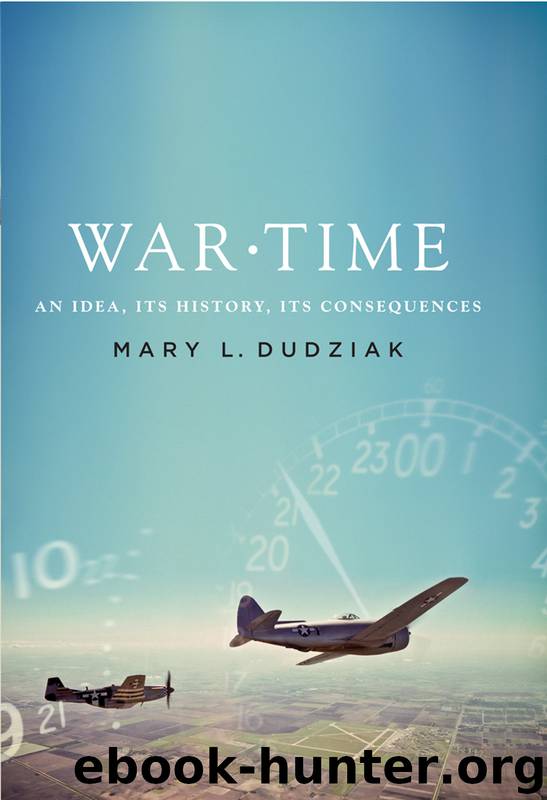War Time by Dudziak Mary

Author:Dudziak, Mary
Language: eng
Format: epub
Publisher: Oxford University Press, USA
Published: 2012-07-22T16:00:00+00:00
LAW DURING WAR WITHOUT END
But was the post-9/11 era really a “wartime”? Legal scholars remain divided in their assessments, debating whether “war” or “state of emergency” is the better way to frame the security environment Americans found themselves in. Many adopted a traditional wartime frame and supported an expansion of executive power, emphasizing the need for government action to address the danger. Others countered that the war on terror did not fit the definition of war under international law. This mattered a great deal, since the switch from peace to war triggers the application of the law of war and international human rights protections, including the Geneva Conventions. The constitutional scholar Bruce Ackerman argued that this was not a war, but an “emergency.” Before long, “emergency” or “crisis” became dominant ways of describing the post-9/11 era. Looking for historical analogies, some scholars have recharacterized wartimes in American history as “emergency times,” and at least one important scholarly paper about the impact of war on American courts was renamed, substituting “crisis” for “war.”32
Underlying the disagreement about how to characterize the post-9/11 era was the concern that “wartime” called for the suspension of normal restrictions on executive power. But if the new era was a wartime, it seemed to have no temporal limits. Ultimately, the constitutional scholar Mark Tushnet argued that the length of the “war on terrorism” means that it is not a war like World War II, but instead is “more like a condition,… more like the war on cancer, the war on poverty, or, most pertinently, the war on crime.” It is one thing to suspend the rule of law during a time-limited war. “Suspending it during a more or less permanent condition is quite another.”33
The search for a definition reveals a broader issue. As during the Cold War era, there was a lack of fit between the conceptual categories of wartime and peacetime, and the geopolitical realities scholars confronted post-9/11. In the past, war was most commonly defined as a conflict between nations, not between a nation and an ideology or what has become known as “non-state actors.” By the end of the twentieth century, the state had dropped out of many definitions of war. A war on terror was more expansive still: it was a war against a tactic or an ideology, not a single, easily identifiable entity. And as the boundaries of territory and identity expanded, this conflict also seemed to defy the idea that war was limited in time.
Most legal scholars responded not by jettisoning the old categories, but by renaming and repurposing them. For example, in a 2005 essay, the legal scholars Samuel Issacharoff and Richard H. Pildes described the dividing line not as between wartime and peacetime, but between “normal times” and “times of heightened risk to the physical safety” of citizens.34 Post-9/11 scholarship has persisted in the assumption that normality is a state of existence outside times of danger. “Wartime” and “peacetime” broke down, but the basic temporal structure (normal times, ruptured
Download
This site does not store any files on its server. We only index and link to content provided by other sites. Please contact the content providers to delete copyright contents if any and email us, we'll remove relevant links or contents immediately.
Last Narco by Beith Malcolm(1540)
Steroids: History, Science, and Issues by Standora Joan E.; Bogomolnik Alex; Slugocki Malgorzata(1499)
A Practical Guide to International Arbitration in London by Hilary Heilbron(1411)
Adrift by Steven Callahan(1337)
40 Days and 40 Nights by Matthew Chapman(1321)
Introduction to the study and practice of law in a nutshell by Kenney F. Hegland(1308)
Reclaiming History by Vincent Bugliosi(1306)
The Nuremberg Interviews by Leon Goldensohn(1285)
Poisoned by Jeff Benedict(1280)
Persuasion by Owner(1275)
Dog Company: A True Story of American Soldiers Abandoned by Their High Command by Lynn Vincent & Roger Hill(1245)
The New Whistleblower's Handbook by Stephen Kohn(1203)
Lincoln's Code by John Fabian Witt(1168)
Kafka's Last Trial by Benjamin Balint(1146)
Eichmann in Jerusalem by Hannah Arendt(1145)
Japanese War Crimes during World War II: Atrocity and the Psychology of Collective Violence by Frank Jacob(1079)
A Passing Fury by A. T. Williams(1057)
Dog Company: A True Story of American Soldiers Abandoned by Their High Command by Roger Hill & Lynn Vincent(1041)
A Court of Refuge by Ginger Lerner-Wren & Rebecca A. Eckland(1022)
